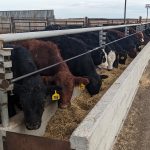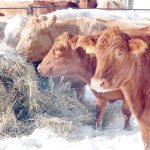Some ranchers have slowly begun taking the first steps to boost cattle production after inventory shrank due to a years-long drought that dried up pastures and hiked feeding costs.
Tag Archives feed cost

U.S. ranchers cautiously rebuild
Consumers have paid record beef prices due to low supply; meat packers want larger cattle herds to reduce cattle prices

Turning waste into weight: making the most of screenings, fines and straw in beef diets
With feed costs at an all-time high, Canadian beef producers are increasingly turning to alternative feedstuffs to cut expenses and improve profitability.

Outlook looks brighter for Canadian hog market
Pork producers have a reason to be optimistic as their feed costs drop and demand from the United States strengthens
Glacier FarmMedia – A decline in feed costs and lower hog supplies should create optimism for hog producers, says Farm Credit Canada. Feed costs as a percentage of revenue are now closer to the historic norm, says FCC senior economist Justin Shepherd. The most recent 2024 data shows feed costs average 63 per cent of […] Read more
Letting heifers rough it has benefits
Babying heifers through their first winter may not improve the cattle herd. Instead, a late gain system can optimize heifers for reproductive success and reduce feed costs by 12 percent, according to one Alberta veterinarian. Dr. Elizabeth Homerosky says the system helps target first-cycle births and avoids overfeeding animals before they hit grass. There is […] Read more

Feed testing becomes important as costs rise
Livestock feed costs are increasing as feed supplies run short. That makes feed testing even more important, said Bree Kelln, assistant professor at the University of Saskatchewan. Feed costs can quickly add up, particularly when winter feeding periods can last for up to 200 days, often in rough weather conditions, said Kelln, during a recent […] Read more



